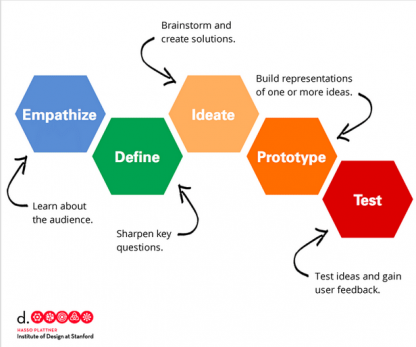Applying design thinking to content creation
When we create content for online channels, we usually work with a hypothesis on what we think users need or want. We make content choices based on this hypothesis. When the product of this ‘guesswork’ goes live, it is then put to test. Do people interact and engage with it?
Measuring user engagement is not straightforward

The more conscientious content creators among us would consult analytics after a while to establish whether our content is working. But these are often difficult to interpret. Most of us would consult bounce rates as a main indicator of user engagement for a start. However, a high bounce rate unfortunately does not tell us what is wrong with our content, only that something is wrong. We can tweak our content here and there, again based on a hypothesis of what may be the cause for low engagement.
These are a lot of hypotheses. In fact, turning low engagement around using analytics can become a lengthy process of trial and error. We tweak, see if it makes a difference, and if doesn’t, tweak again. Somewhere down the line bounce rates will move towards a more acceptable level.
Good content is also rewarded by search engines
The problem is: Meanwhile, we may be losing leads and sales. And perhaps just as importantly, we may be affecting our search engine ranking. However, so-called ‘UX signals’ such as bounce rate, dwell time and click-through rate, have no impact on Google’s ranking, according to an article in Search Engine Journal quoting Google’s Gary Illyes. Valuable content that meets users’ needs or wants does. Users reveal these in their search queries, and search engines like Google have built language models that try to “understand” users’ search intent and reward content that matches it.
So if a search algorithm can understand what our customers want, then why not us? First, we need to recognize how most users behave when they consume content online. They’re often on a quest, looking for a quick answer to a question or solution to a problem with little patience for any ‘noise’ that gets into the way. Consequently, content they consider valuable is content that gives them answers to their queries or shows them how a product or service solves their problems. The content we need to create should be in response to these queries, and there are many tools out there that help us establish what they are, e.g. Google Correlate.
User research
This type of user research is only one way to make a more informed hypothesis on what users want. Another is to empathize with users. Commonly used tools that help us get into the mind of our users are personas, empathy maps or user journey maps. More data-driven research such as market intelligence, survey results, usability tests or insights from customer service can help complete the picture that emerges from empathizing with user groups. Some of these methods are more costly than others and, for some, perhaps out of reach. But the more research we conduct, the more real our concept or definition of a ‘user point of view’ becomes.
User research puts us in a better position to make informed decisions on what users want. The next step would be to brainstorm content ideas based on this research.
Content creators are designers
Confirming or disproving a hypothesis until it is reasonable to assume that it is correct is very similar to what scientists do. However, when creating content, operating with an informed hypothesis can save a lot of time and money and helps avoid costly guesswork.
Another way of avoiding the costs of wrong assumptions is by building a prototype and testing it on a few users before going live. Prototyping delivers proof that we were right with our definition and obviously also confirms when we were wrong. The insights gained from the way users interact or struggle with the content we create enable us to develop a user-centered result.

Empathizing with users, defining a concept of a user point of view, ideating content, prototyping and testing are all phases of the design-thinking process.
Design thinking is not a new methodology. It has been used for decades to solve problems and develop solutions. Applications have grown ever since; now, design thinking is applied to products, services, strategies, architecture, even business models. In fact, design thinking is being hailed as “the single biggest competitive advantage that you can have” because it puts customers first. Designing content based on real user needs is putting their interests and information needs first. The result is user-centered content design.
Jacqueline Vitacco
Kommentare
Keine Kommentare erfasst zu Applying design thinking to content creation